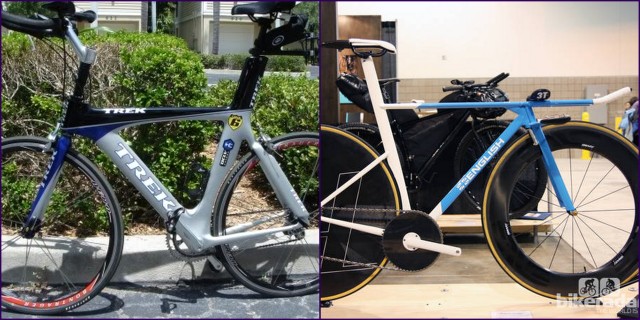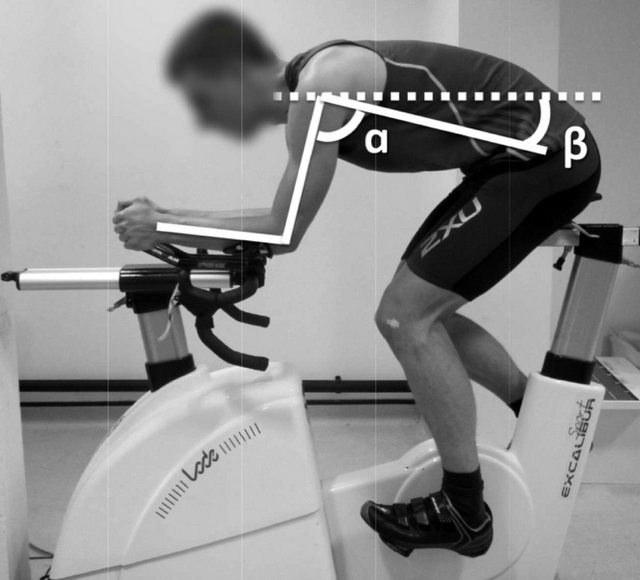Bicycle time trailing in Triathlon and Road Cycling are quite distinct. The main difference is that in a triathlon you need to jump off the bike and run after the cycling leg, whilst after a fast road cycling time trial, you should probably be too fatigued to walk, let alone run, afterwards. You can read some other informative posts on running and triathlon warm-up routines on our blog too.
The intensity of the cycle effort needs to be less for a given distance in a triathlon compared to a cycling time trial. The position on the bike also needs to be different to account for correct running posture and the different muscles required. Despite these facts, plenty of triathletes set up their time trial bikes with little distinguishing features from a traditional road cycling time trial position.

IS THE MOST AERODYNAMIC POSITION ALWAYS THE FASTEST?
Comfort and the running aspect of triathlon aside, getting too low at the front by lowering your torso too much can result in reduced power output. This is probably because it reduces your hip angle too much.
A study of 19 trained cycling time trialists analysed power output and efficiency at torso angles 0-24° (see figure 1). The study found that a horizontal torso angle did not produce the greatest power output, nor was it the most energy efficient. (Fintelman et al., 2014)
The optimal torso angle strongly depends on speed. Power loss due to getting too low, leading to a reduction in the force that the muscles can produce is outweighed by the aerodynamic benefits at speeds above 46km/h. However, the improved aerodynamics means that less power is actually required for a given speed. For speeds below 30km/h, it is beneficial to ride in a more upright TT position.

LOW TORSO ANGLE ADVANTAGES AND DISADVANTAGES
ADVANTAGES OF A LOW TORSO ANGLE
- 1. Reduced frontal area and reduced drag.
- 2. A difference in drag area of approximately 16% for torso angles between 2-20° (Underwood et al., 2011).
- 3. A reduction in aerodynamic drag of approximately 35% is found between an upright position and a low time trial position (Hennekam, 1990).
- 4. You look fast!
DISADVANTAGES OF A LOW TORSO ANGLE (FACTORS THAT CAN REDUCE POWER)
- 1. Muscles not working in their optimal range.
- 2. A difference in muscle recruitment.
- 3. Greater muscular fatigue.
- 4. Increased pressure on shoulder griddle, neck and arms.
- 5. Increased adductor activation to keep the leg movement in the sagittal plane due to the extreme hip angles.
In my opinion as a triathlete and an Osteopath there is a lot of sense in achieving an advantageous aerodynamic position. However, it can take some work to get into the position and more time to become efficient in that position. If you are limited in flexibility or have been quite upright previously it takes more work. Certainly sitting all day for work can make it difficult to straighten your back and relax your neck and shoulders to achieve this position.
The next post will discuss some tips to get your body used to an aggressive TT position, including an interview with colleague and super biker triathlete Ryan Bourke. We will show you how Ryan used manual therapy to improve his TT position to be one of the fastest in Melbourne’s Gatorade triathlon series. To read up on more of Ryan’s great knowledge of the sport, check out his website and social media feeds:
If you would like to book an appointment with Brendan to discuss how to improve your time trial position, then call Melbourne Osteopathy Sports Injury Centre on (03) 9939 1289 or email us at info@melbourneosteopathycentre.com.au
Brendan also offers bicycle fitting services at Rapido Cycles Essendon
(03) 9379 5292 | info@rapidocycles.com | Twitter | Facebook
REFERENCES:
Fintelman, D. M., Sterling, M., Hemida, H., & Li, F. X. (2014). Optimal cycling time trial position models: Aerodynamics versus power output and metabolic energy. Journal of biomechanics.
Hennekam, W. (1990). The speed of a cyclist. Physics Education, 25(3), 141.
Underwood, L., Schumacher, J., Burette-Pommay, J., & Jermy, M. (2011). Aerodynamic drag and biomechanical power of a track cyclist as a function of shoulder and torso angles. Sports Engineering, 14(2-4), 147-154.
